管理沟通教学(英文版4版)案例课件10_Oak Brook Medical Systems, Inc
- 格式:ppt
- 大小:390.00 KB
- 文档页数:12


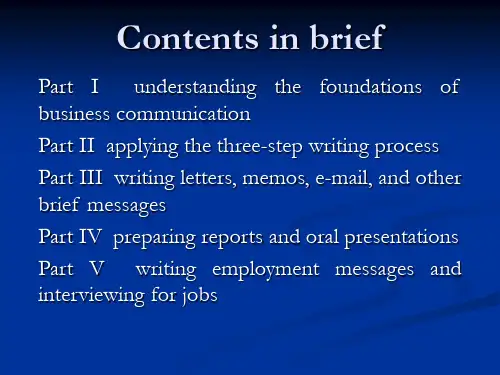


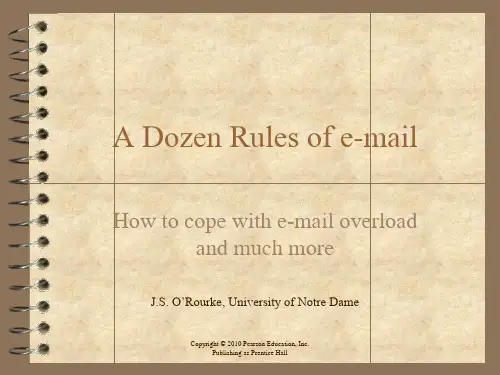
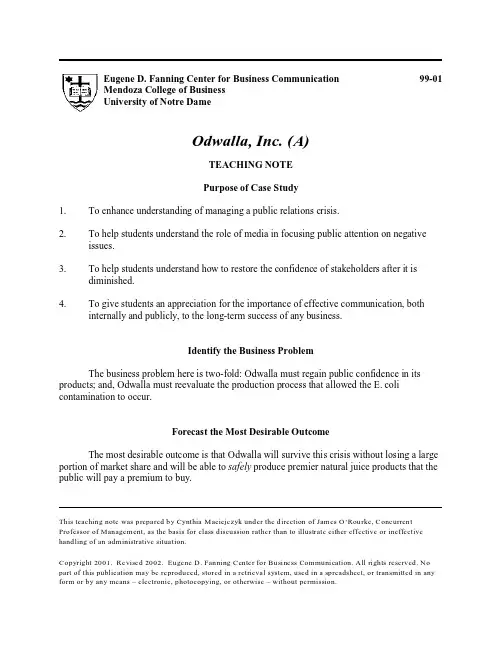
Eugene D. Fanning Center for Business Communication99-01Mendoza College of BusinessUniversity of Notre DameOdwalla, Inc. (A)TEACHING NOTEPurpose of Case Study1.To enhance understanding of managing a public relations crisis.2.To help students understand the role of media in focusing public attention on negativeissues.3.To help students understand how to restore the confidence of stakeholders after it isdiminished.4.To give students an appreciation for the importance of effective communication, bothinternally and publicly, to the long-term success of any business.Identify the Business ProblemThe business problem here is two-fold: Odwalla must regain public confidence in its products; and, Odwalla must reevaluate the production process that allowed the E. coli contamination to occur.Forecast the Most Desirable OutcomeThe most desirable outcome is that Odwalla will survive this crisis without losing a large portion of market share and will be able to safely produce premier natural juice products that the public will pay a premium to buy.This teaching note was prepared by Cynthia Maciejczyk under the direction of James O’Rourke, Concurrent Professor of Management, as the basis for class discussion rather than to illustrate either effective or ineffective handling of an administrative situation.Copyright 2001. Revised 2002. Eugene D. Fanning Center for Business Communication. All rights reserved. No part of this publication may be reproduced, stored in a retrieval system, used in a spreadsheet, or transmitted in any form or by any means – electronic, photocopying, or otherwise – without permission.Identify the Critical IssuesThese are the main issues involved in this case:§Managing the company’s public response to the crisis;§Assessing the damage done to the company’s reputation;§Reevaluating the company’s stance on pasteurization process (in view of its commitment to an “all-natural” product);§Reviewing company's core values to see how they may have contributed to the development of the crisis;§Regaining public trust in the company and its products;§Managing costs involved in the crisis response.Stakeholder perspectives include:§Consumers;§Retailers;§Vendors, suppliers;§Shareholders;§Odwalla Employees;§Seattle-King County Department of Public Health;§Washington State Department of Health;§Rival juice makers;§Organic food industry.Identify and Discuss Possible Solutions to the Problem1.Order an immediate recall of all juice products containing apples. This shows theconsumers that the company is aware of the problem and that Odwalla is trying to ensure their health and safety by recalling all products that may be tainted.22.Cooperate fully with the government agencies investigating the outbreak (Seattle-KingCounty Department of Public Health, Washington State Department of Health, USFDA).Odwalla could choose not to cooperate but this would certainly make it difficult for thecompany to maintain its positive public image as a people-focused, socially consciouscompany.3.Reevaluate the production process. Odwalla juices are not pasteurized, allowing for thepossibility of dangerous bacteria in the products. How can Odwalla prevent futureoutbreaks of this kind?4.Reevaluate core values of the company. The company is committed to using minimalproduction processes to deliver superior taste and nutritional value. Is it feasible for them to stick to this core value in light of the E. coli outbreak?5.Pull a team together to find out as much as possible about all victims of the outbreak.Who are they; what was the impact on their health?6.Develop a communication strategy that addresses the health and safety concerns of thepublic as well as informs all stakeholders what Odwalla is doing to address the problem.7.Meet with company employees to address their concerns and communicate the company’spublic relations strategy.Explain How to Communicate the SolutionSound public relations communication strategies will help address the issues. In particular, Odwalla must show the public that it is concerned about the health and safety of its consumers. By developing a clear communication strategy for the media, the officers of the company can convey how they are dealing with the crisis to their stakeholders: consumers, the public at large, their retailers, the government agencies involved, the company’s shareholders, and the company's employees.Strategies may include a press release, talking with the local and national media, point-of-sale information brochures, letters to the victims of the E. coli outbreak, company memos to employees describing the company’s response to the crisis (group meetings), posting information to the company's Web site, e-mailing or writing to shareholders, memos to retailers, to name a few.Odwalla did order an immediate recall of all juice products containing apples and carrots (which were handled on the same production line). The company earned high marks from the media for its quick and candid public response to the problem. An article published in the San Francisco Chronicle on November 2, 1996 by staff writer Kenneth Howe stated that many “in the public relations community credit Odwalla with moving quickly to institute a voluntary3recall, cooperating with the Food and Drug Administration and offering to pay the medical expense of victims affected by contaminated Odwalla products.”Teaching the CaseOne week priorDistribute the case at least one lesson before you intend to discuss it in class. Tell the students that you will focus on several issues during the discussion of the case, including the following:§Managing a public relations crisis;§Dealing with negative media representation;§Identifying the key issues of the case;§How the core values of this company may have contributed to the crisis;§Identifying the major stakeholder groups in this situation.First 30 minutes of the classSpend the first 5-10 minutes of the class session briefly recapping the facts of the case. Then, for the next 20 minutes, have the students identify the issues listed above.Some points for student consideration may include:The public's likely response to the health report linking the E. coli outbreak to Odwallaapple juice.The company’s core values and their impact on the production process. Can the company continue to produce its products without performing some sort of pasteurization process?The media’s role in publicizing the health crisis. How can Odwalla use the media to their advantage in this crisis?Next, identify the stakeholders in this case and their separate interests and concerns: Retailers. Odwalla’s retailers are Consumers. The consumers of Odwalla juices are most likely well educated people who care about their health and the health benefits of theproducts they consume. This group also doesn't mind spending a bit more for high-quality, “fresh,” and natural products, such as Odwalla’s juices. However, they are likely to react strongly to the news that their juice may be contaminated. They will pay attention to the news stories and expect information from the company.4Retailers are also very important to Odwalla’s distribution scheme. Odwalla depends on its retailers to stock fresh product every day. As such, it is important for Odwalla tomaintain goodwill with its retailers to protect this relationship. One way to preserve this goodwill is to keep them informed of all relevant developments in a timely manner.Odwalla Employees. The company's employees also factor in this crisis. If Odwalla does not have the financial resources to ride out the storm or if it mishandles the crisis, theemployees will lose their jobs. They have a vested interest in doing what they can to help out. They will also want to know what the company's plans are.Shareholders. This group will be concerned about the financial well-being of thecompany as it steers through this storm. Management needs to keep this group informed so that shareholders will not panic and sell. As reported at the time, there was a 34percent drop in the price of Odwalla stock on the announcement of the E. coli outbreak.Seattle-King County Department of Public Health, Washington State Department ofHealth, and the U.S. FDA. Although not mentioned specifically in the text of the case, the U.S. FDA will perform an investigation at the manufacturing plant to see if it candetermine how the juice was contaminated with e.coli. Once the investigation iscompleted the FDA will release a report to the general public.Rival juice makers. Odwalla’s competitors will be watching closely to see how Odwalla handles this crisis. Many will seek to capitalize on Odwalla’s misfortune (particularlythose companies that already pasteurize their own products) and others (Odwalla’s rivals in the “natural” juice market) will feel the heat of this situation from their own customers.Many consumers of rival natural juices will stop drinking them because these juices also are not pasteurized. These companies will also be concerned about the fallout of the FDA investigation (e.g., stricter processing regulations, perhaps mandated pasteurization).Organic food industry. The organic food industry in general will be watching this casebecause the results of the FDA investigation and the public outcry over the safety of thefood supply may affect sales in this industry.Last portion of classSummarize student responses. Ask students for their communication plan. What would they do in Odwalla management’s shoes?Issues to consider include:Strategic communication objectives. What are Odwalla’s strategic business objectives and how can they be linked directly to the communication objectives?5Audience analysis. Who are we most concerned about reaching? Why do we want tocommunicate with them? What outcome do we hope for when we reach them?Message Construction. What do we want to say to each of these audiences? Will ourmessage differ from one set of stakeholders to another? How simple or complex should the message be?Medium Selection. How should we try to reach these stakeholders? Should we consider electronic means? How about print means? Should we telemediate our message through the press? Should we try to communicate directly with one or more of the stakeholder groups?Measurement of outcome. How will we know if we have succeeded? What criteriashould we use to determine success? If we're not successful, what should we considerchanging first: medium, message, audience, or objectives?Last 5 minutes of classConclude the discussion.The key to this case, as with nearly all other management communication cases, is to let the students speak freely, but guide their comments toward the problem facing Odwalla and the communication issues the case presents.Timetable of EventsThis timetable of events is included for your reference. A list of discussion questions follows.Questions for DiscussionThese questions are for use in class and may help provide a deeper level of understanding-they will be most helpful after the case has been digested by the students and some initial revision of the case has taken place. Discussion questions should focus on communication issues involved in the case.1.What is the best way to communicate with the different stakeholders?2.What is Odwalla's responsibility to the consumers who were afflicted with bacteria? Howshould management go about communicating with these people?3.When Odwalla comes up with a plan to address the safety of their juice products, howshould this plan be communicated to the public? To their retailers?4.How would Odwalla benefit by taking a leadership role within the industry on the issueof ensuring product safety? How would this fit in with the company's overallcommunication strategy for this crisis?。
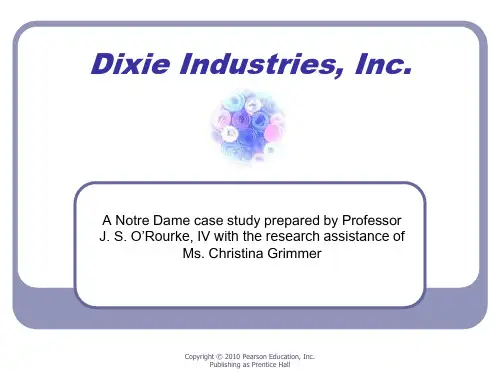
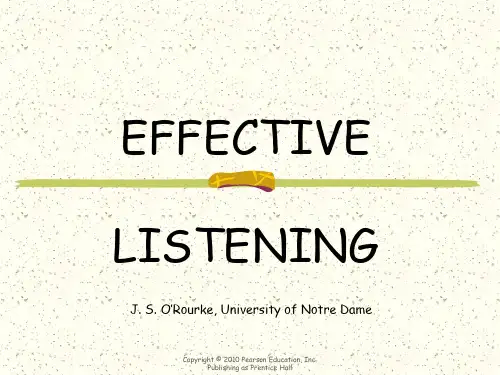

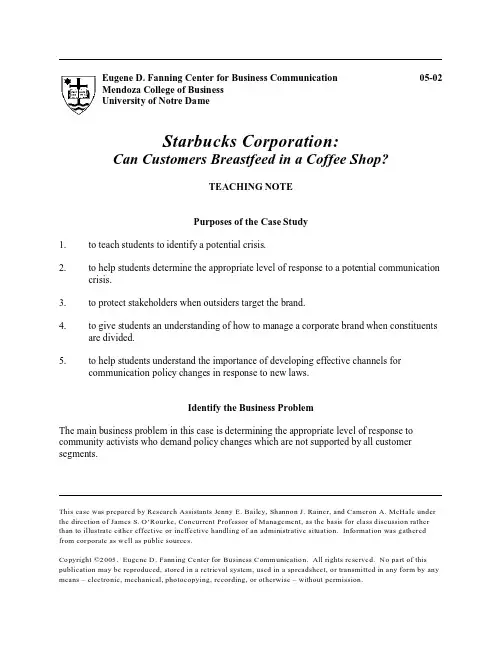
Eugene D. Fanning Center for Business Communication05-02Mendoza College of BusinessUniversity of Notre DameStarbucks Corporation:Can Customers Breastfeed in a Coffee Shop?TEACHING NOTEPurposes of the Case Study1.to teach students to identify a potential crisis.2.to help students determine the appropriate level of response to a potential communicationcrisis.3.to protect stakeholders when outsiders target the brand.4.to give students an understanding of how to manage a corporate brand when constituentsare divided.5.to help students understand the importance of developing effective channels forcommunication policy changes in response to new laws.Identify the Business ProblemThe main business problem in this case is determining the appropriate level of response to community activists who demand policy changes which are not supported by all customer segments.This case was prepared by Research Assistants Jenny E. Bailey, Shannon J. Rainer, and Cameron A. McHale under the direction of James S. O’Rourke, Concurrent Professor of Management, as the basis for class discussion rather than to illustrate either effective or ineffective handling of an administrative situation. Information was gathered from corporate as well as public sources.Copyright ©2005. Eugene D. Fanning Center for Business Communication. All rights reserved. No part of this publication may be reproduced, stored in a retrieval system, used in a spreadsheet, or transmitted in any form by any means – electronic, mechanical, photocopying, recording, or otherwise – without permission.Forecast the Most Desirable OutcomeThe most desirable outcome is for the Starbucks brand to remain untarnished. The nature of the attack makes determining the appropriate response problematic. The company does not want to draw further attention to the situation, which is what the breastfeeding group desires. In addition, the agitators do not represent Starbucks’ core constituents, who would dislike a child-focused coffee shop.The company has promised to abide by all state laws regarding breastfeeding; in an ideal world, this would satisfy Lorig and her supporters. Starbucks most desirable outcome is to maintain control over its corporate policies and the atmosphere within its stores. However, breastfeeding advocates are demanding corporate policies which would make Starbucks the driving force to reshape the retail community in the United States.Identify the Critical IssuesThe issues at the heart of the case:•Determining the appropriate level of response to the breastfeeding activists.•Identifying the costs associated with satisfying the demands of one customer segment while alienating others.•Determining the corporate stance on public breastfeeding and communicating that stance and resulting policy changes throughout the organization.•Remaining aware of changes in legislation which affect corporate policies at the store level and communicating those changes to the store employees.•Developing a consistent corporate policy regarding breastfeeding when the laws of different states are in conflict.Stakeholder perspectives include:•Starbucks’ managers and employees;•Breastfeeding advocates;•Starbucks’ customers;•Other corporate retailers;•State legislators.2Identify and Discuss Possible Solutions to the Problem1.Implement corporate breastfeeding policy and post signs to that affect in stores.2.Abide by state laws and ignore protesting advocates in hopes that the problem disappears.3.Make store changes that provide special accommodations (e.g. separate sitting areas) forbreastfeeding mothers.4.Maintain accurate records of customer complaints by topic within each coffee shop.5.Flag national media relating to breastfeeding policies in retail establishments.Explain How to Communicate the SolutionStarbucks’ main focus should be internal communication. It must relay state legislation and corporate policies regarding breastfeeding in all of its coffee shops in a clear, concise manner. Starbucks must also have a spokesperson available for comment externally when needed. The company has already commented on the breastfeeding issue and its company’s promise to abide by all legislation. It must also determine how to communicate breastfeeding legislation to non-breastfeeding customers who may complain about breastfeeding mothers in the store.Potential Difficulties1.Understanding how an apparently small issue can develop into a company crisis.2.Understanding that this case is not a result of any wrongdoing on Starbucks’ part, but israther a case of activists attempting to hijack the brand for their own ends.3.Developing a corporate policy that does not alienate customer segments but which stillabides by all state and local laws.Teaching the CaseAssign the case reading in a timely manner to allow students to prepare for class discussion. Tell students to brainstorm about several of the following items:•Key business problems;3•Issues to address;•Stake holders;•Potential solutions.Class DiscussionFirst Few MinutesUse the first few minutes to give a brief overview of the focus of the case.Remainder of Class TimeUse included PowerPoint slides (or some equally effective means) to discuss the following:•Case facts: company, background, etc.;•Critical issues;•Stakeholders;•Solutions.Also available for class discussion: A Summary of Breastfeeding Legislation in the United States. (Can be used as an ice breaker or additional discussion when case is complete.)Some points for student consideration may include:Breastfeeding Policy: Starbucks may want to consider breastfeeding policies established by other companies within its industry. Several other companies (e.g. Burger King) have been faced with similar protests by breastfeeding advocates. It may prove beneficial to see how these companies handled breastfeeding demands and how corporate policies and brand images were affected.Health Benefits of Breastfeeding: In Starbucks’ case, the breastfeeding protesters have demanded company-wider changes regarding breastfeeding based on the health benefits created by the act. Students may want to consider these benefits to help develop a solution that does not belittle the importance of breastfeeding.Alienating Customers: The decision to implement a policy supporting breastfeeding in Starbucks cafés will be extremely difficult because of conflicting views held by different customer segments. Some customers would prefer to enjoy their coffee without the view of a breastfeeding mother while other customers and mothers support the right to breastfeed in public. Starbucks4must consider solutions that will satisfy both groups, or determine which party is more essential to the success of the business.Conflicting State Laws: As noted in the case, breastfeeding legislation differs by state. Starbucks must decide how to implement a corporate policy which obeys each state’s laws without the burden of implementing separate policies in each store. Students should consider whether a company-wide policy is feasible or if Starbucks should develop a system to satisfy each state’s law on an individual basis.Future Disputes with Breastfeeding Advocates: Starbucks must decide if a reaction to breastfeeding advocates is needed. In making that decision, students must consider the potential effects on Starbucks if advocates remain focused and are able to draw media attention to their cause. If the breastfeeding conflict does not subside on its own, there may be future disputes with advocates. Students must assess the affects of those disputes, if any, on the Starbucks image.Next, identify the stakeholders in this case and their separate interests; review the pertinent assumptions made by each of the stakeholder groups.Starbucks’ Managers and Employees: These stakeholders want to see Starbucks succeed and do not want the brand image to be damaged. This crisis has the potential to diminish the company’s customer base and create policy changes and conflicts within the states that may affect day to day managerial responsibilities.Breastfeeding Advocates: These stakeholders want Starbucks’ breastfeeding problem to resolve in a manner which enhances the creditability of their cause and pushes in the direction of changes across retailers.Customers: This group of stakeholders may have conflicting views. On the one hand, there is a group of customers (e.g. breastfeeding mothers) which wants to see company-wide policy changes at Starbucks. On the other hand, there are many customers who would like to see policies remain the same and who would like to enjoy Starbucks products without feeling uncomfortable. The outcome of the breastfeeding crisis will affect each group’s future experiences at Starbucks.Other Retailers: The stakeholders want to see Starbucks resolve the breastfeeding issue without drastic changes to its corporate policies and procedures. They realize that Starbucks has been chosen to set the precedent for all retailers. If Starbucks loses control of its corporate policies and brand image, they can expect to become the foci of similar protests in the future.State Legislators: These stakeholders may find themselves under increased pressure as a result of the outcome at Starbucks. Protesters may target legislators under the assumption that some states are lacking sufficient laws regarding breastfeeding. Protesters may be tempted to shift the focus from Starbucks to legislators in order to find another method of advancing their cause.5In addition, legislators looking for ways to attract the “soccer mom” demographic may also find this an attractive topic.The decision options available to Starbucks:•Ignore Protesters. What potential problems could arise from this option?•Implement a formal policy. What potential problems could arise from this option?•Implement policies on a state-by-state basis. What potential problems could arise from this option?Summarize Student Responses Through a Communication PlanItems to consider when developing a plan:•Objectives. Look at Starbucks critical and business objectives or goals.•Audience. Determine whom Starbucks is addressing. Who will the message reach? What does Starbucks want each audience to extract?•Message. Construct a message that conveys ideas which address all stakeholders. Address the message from all levels: complexity, length, and tone.•Channel. Determine the best way to reach the desired audiences. Consider whether several channels are needed to reach different stakeholders.•Measurement. Develop a measurement process which can determine the successfulness of the communication. Potential measures of effectiveness include: satisfaction of customer segments, decreases in complaints and protests, etc.Questions for DiscussionThese questions can be used to guide class discussion after students have had a chance to comprehend the inherent issues.1.Should Lorig’s group’s demands be taken seriously, or are they just another case ofridiculous requests which can be safely ignored by the company?2.Is there a reasonable way for Starbucks to satisfy all customer segments?63.Assuming Starbucks adopts an official policy, how can it effectively communicate thepolicy throughout the company?4.When state laws which affect store operations change, how can Starbucks communicatethe new laws to stores in that state to ensure that all stores are in compliance?7。